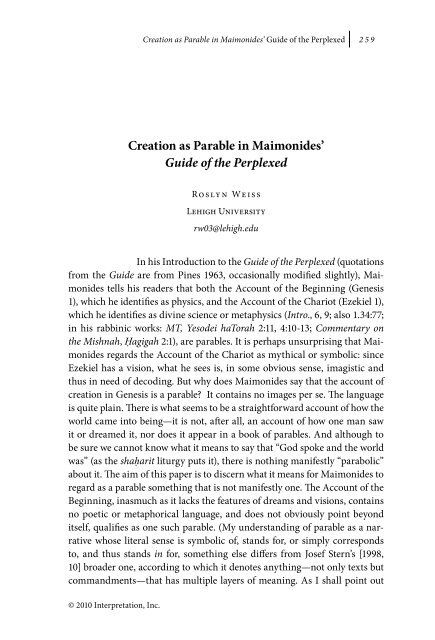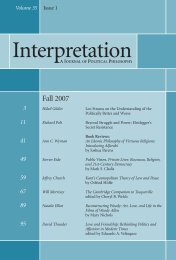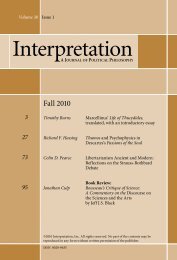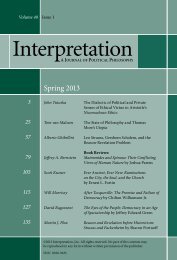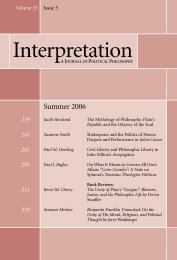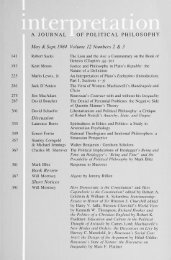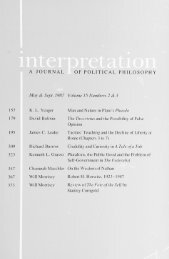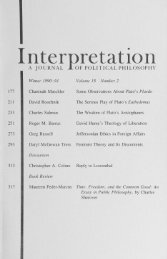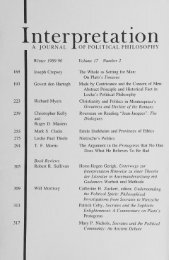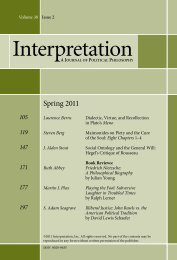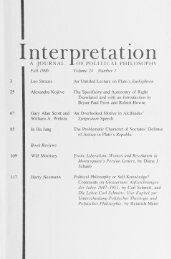Spring 2010 - Interpretation
Spring 2010 - Interpretation
Spring 2010 - Interpretation
Create successful ePaper yourself
Turn your PDF publications into a flip-book with our unique Google optimized e-Paper software.
Creation as Parable in Maimonides’ Guide of the Perplexed<br />
2 5 9<br />
Creation as Parable in Maimonides’<br />
Guide of the Perplexed<br />
Ro s ly n We i s s<br />
Lehigh University<br />
rw03@lehigh.edu<br />
In his Introduction to the Guide of the Perplexed (quotations<br />
from the Guide are from Pines 1963, occasionally modified slightly), Maimonides<br />
tells his readers that both the Account of the Beginning (Genesis<br />
1), which he identifies as physics, and the Account of the Chariot (Ezekiel 1),<br />
which he identifies as divine science or metaphysics (Intro., 6, 9; also 1.34:77;<br />
in his rabbinic works: MT, Yesodei haTorah 2:11, 4:10-13; Commentary on<br />
the Mishnah, Ḥagigah 2:1), are parables. It is perhaps unsurprising that Maimonides<br />
regards the Account of the Chariot as mythical or symbolic: since<br />
Ezekiel has a vision, what he sees is, in some obvious sense, imagistic and<br />
thus in need of decoding. But why does Maimonides say that the account of<br />
creation in Genesis is a parable? It contains no images per se. The language<br />
is quite plain. There is what seems to be a straightforward account of how the<br />
world came into being—it is not, after all, an account of how one man saw<br />
it or dreamed it, nor does it appear in a book of parables. And although to<br />
be sure we cannot know what it means to say that “God spoke and the world<br />
was” (as the shaḥarit liturgy puts it), there is nothing manifestly “parabolic”<br />
about it. The aim of this paper is to discern what it means for Maimonides to<br />
regard as a parable something that is not manifestly one. The Account of the<br />
Beginning, inasmuch as it lacks the features of dreams and visions, contains<br />
no poetic or metaphorical language, and does not obviously point beyond<br />
itself, qualifies as one such parable. (My understanding of parable as a narrative<br />
whose literal sense is symbolic of, stands for, or simply corresponds<br />
to, and thus stands in for, something else differs from Josef Stern’s [1998,<br />
10] broader one, according to which it denotes anything—not only texts but<br />
commandments—that has multiple layers of meaning. As I shall point out<br />
© <strong>2010</strong> <strong>Interpretation</strong>, Inc.


